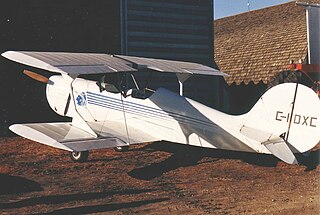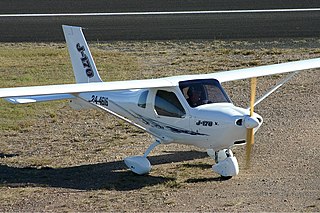
The Aero Boero AB-115 is an Argentine civil utility aircraft. It was developed from the AB-95-115, a refined AB-95 with a more powerful engine and improved aerodynamics. Specific differences included wheel spats, a redesigned engine cowling molded of fiberglass, and aluminum ailerons and flaps.

The UltraFlight Lazair is a family of Canadian designed and built twin-engine ultralight aircraft that were sold in kit form between 1979 and 1984.

The Fantasy Air Allegro is a Czech two seat, high wing, tricycle gear, single engine monoplane light-sport aircraft or microlight originally designed and built by Fantasy Air and later produced in the United States by Allegro LSA.

The Remos G3 Mirage and Remos GX are German high wing, two seat, single engine light aircraft, built by Remos AG of Pasewalk. The aircraft is supplied as a kit for amateur construction or complete and ready-to-fly.

The Aero-Works Aerolite 103 is an American single seat, high-wing, pusher configuration ultralight aircraft, designed by Terry Raber and introduced by Aero-Works, Inc, of Millersburg, Ohio, in 1997. The aircraft's model number indicates that it was designed to comply with the Federal Aviation Administration FAR 103 ultralight rules.

The Lockwood Drifter is a family of high wing, single engine, pusher configuration, open cockpit, one and two-seat kit aircraft that was first introduced in the 1980s by Maxair and remains in production today by Lockwood Aircraft of Sebring, Florida.

The Fisher Celebrity is a Canadian two-seat, conventional landing gear, single engined, biplane kit aircraft designed for construction by amateur builders. Fisher Flying Products was originally based in Edgeley, North Dakota, United States but the company is now located in Dorchester, Ontario, Canada.

The Fisher Classic is a Canadian two-seat, conventional landing gear, single-engined, biplane kit aircraft designed for construction by amateur builders. The aircraft is a two-seat derivation of the Fisher FP-404. Fisher Flying Products was originally based in Edgeley, North Dakota, USA but the company is now located in Woodbridge, Ontario, Canada.
The Fisher Youngster is a Canadian single-seat, conventional landing gear, single-engined, biplane kit aircraft designed for construction by amateur builders. The aircraft was inspired by the German Bücker Bü 133 Jungmeister aerobatic aircraft of the 1930s.

The Murphy Renegade is a family of Canadian two-seats-in-tandem, single engine, conventional landing gear, biplanes, produced by Murphy Aircraft and intended for amateur construction.
The Hy-Tek Hurricane 103 is a family of single-engined, high wing tricycle gear-equipped aircraft that were available in kit form from Hy-Tek Hurricane of Aurora, Oregon.

The CFM Shadow is a British Microlight or Group A aircraft designed in the 1980s by David Cook who went on to run ‘Cook Flying Machines’ - where the aircraft was manufactured as a choice of a BMAA fully built machine or an LAA home build kit. It is of high wing, pusher, pod and boom layout and seats two. Around 400 have been built.

The Coavio DF 2000 is a single-engine, high-wing all-metal ultralight aircraft with side-by-side seating for two. Built in Italy, production began in 2004.

The Sport Flight Talon is a high-wing, pusher configuration single-engine, conventional landing gear homebuilt aircraft or ultralight aircraft, that was produced by Sport Flight Aviation of Sandy, Oregon in kit form for amateur construction.

The Joplin Tundra is a family of Canadian, high-wing, strut-braced, pusher configuration ultralight aircraft that was originally produced by Back Forty Developments of Campbellford, Ontario, Canada and later by Joplin Light Aircraft of Joplin, Missouri and Laron Aviation of Borger, Texas for amateur construction. The aircraft is out of production.

The Jabiru J170 is an Australian ultralight and light-sport aircraft, designed and produced by Jabiru Aircraft. The aircraft is supplied as a kit for amateur construction or as a complete ready-to-fly-aircraft.
The Anglin J6 Karatoo is an Australian ultralight and light-sport aircraft that was designed by Jesse Anglin and introduced in 1982. Over the years the J6 Karatoo has been produced by several different manufacturers, including Amax Engineering of Donvale, Victoria, Skyway Aircraft and is currently built by Serenity Aviation of Australia. The aircraft is supplied as plans or as a kit for amateur construction.

The Rainbow Cheetah a South African ultralight and light-sport aircraft, designed by Vladimir Chechin and produced by Rainbow Aircraft. The aircraft is supplied as a kit for amateur construction or as a complete ready-to-fly-aircraft.

The Freedom Lite SS-11 Skywatch is a Canadian ultralight aircraft that was produced by Freedom Lite of Walton, Ontario and later by Legend Lite of New Hamburg, Ontario, introduced in 1996. When it was available the aircraft was supplied as a complete ready-to-fly-aircraft, or as a kit for amateur construction.
The Albaviation D24 MagicOne is an Italian ultralight aircraft designed and produced by Albaviation. The company was at one time located in Corropoli, but is now in Montegiorgio. The aircraft is supplied as a kit for amateur construction or complete and ready-to-fly.





















